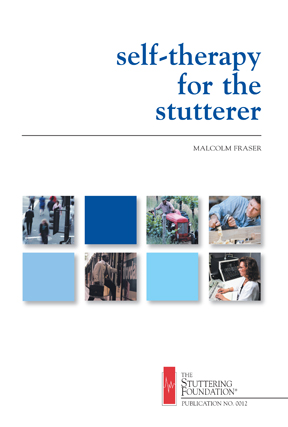 An excerpt from the book Self-Therapy for the Stutterer
An excerpt from the book Self-Therapy for the StuttererThe first rule calls for you to build a habit of talking slowly and deliberately, whether or not you stutter. This is recommended for a couple of reasons. First, it induces a manner of talking which is generally respected and admired, and secondly, it will result in a more varied, relaxed manner of speaking which is more responsive to therapy controlled procedures.
Temporarily accepting your role as a stutterer, resolve to make a special effort to talk slowly and deliberately all the time.1 This will not be easy to do if you normally speak fairly rapidly. It may take considerable effort to talk slowly whenever you speak.
It will help if you can spend at least five to ten minutes a day practicing when you are alone. You might read to yourself at a gradual slow rate in line with what you should use in conversation with others. Then possibly think of some subject about which you are informed and talk to yourself slowly and deliberately.
When you are with others, always try to resist feelings of time pressure. At the moment you are expected to speak, you may sometimes have an almost panicky feeling of haste and urgency.2,3 You think that you are under “time pressure” with no time to lose, and you have a compulsive feeling that you must speak quickly without taking the time for deliberate and relaxed expression. Do your best to resist this time pressure feeling.4,5
Stutterers are also apt to fear silence when they are embarrassed. Accordingly, it is suggested that when talking, you should experiment with occasionally pausing. When speaking a sentence, pause momentarily (very briefly) between words and between phrases. There is no hurry—probably you are not taking as much time as you think—take your time. Unless there is a fire, people will wait to hear what you have to say. Let them wait and don’t hurry saying “hello” on the phone. Pause! Take your time.
If you have a tape recorder available, this is an opportune time to make a recording of the way you talk, particularly if you have not yet started speaking according to the recommendations of this first rule.
Making a recording of the way you usually stutter will supply important information to be used in this program.6 For example, listening to such a recording should help you discover what, if anything, needs to be done to qualify you as speaking slowly and deliberately.
The question arises as to what may be the best way to get a recording of your stuttering. If you have trouble talking on the phone, you might place a microphone near when you make several phone calls—at least five or possibly ten minutes of recording time is desirable.
Then later, take the time to listen to the recordings. Did you talk slowly and deliberately and thus set an example of the rate at which you should speak? Later you will use these recordings to study your speech.
Of course if possible, it would be even more advantageous in studying your speech if you could have videotapes made of the way you talk. This enables you to both see and hear yourself at the same time.
1 Try stuttering slowly. Keep stuttering, but do it in slow motion. (Guitar)
2 I have always felt a great pressure to give a reply within a split second and with just the right and exact words. Other stutterers feel this, too. Isn’t it silly? (Garland)
3 Stutterers generally stutter too fast and get into tremors because they do. (Van Riper)
4 Panic, tension, and an overwhelming urgency are the hallmarks of stuttering; they are what you must overcome. Totally resist any feelings of hurry and pressure. Let ’em wait. (J. D. Williams)
5 A basic feature of stuttering behavior is that the stutterer is under time pressure to a great extent. The stutterer has to learn how to permit pauses in his speech, to risk the fear of silence, to give himself time to catch his breath to resist the time pressure. (Sheehan)
6 A tape recorder will prove a good investment for the stutterer. (Bluemel)






 Podcast
Podcast Sign Up
Sign Up Virtual Learning
Virtual Learning Online CEUs
Online CEUs Streaming Video Library
Streaming Video Library